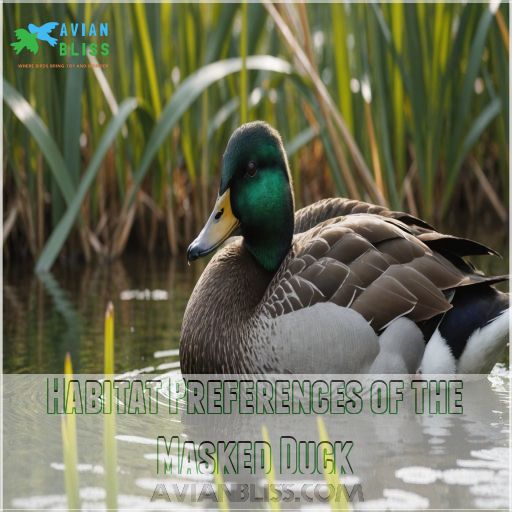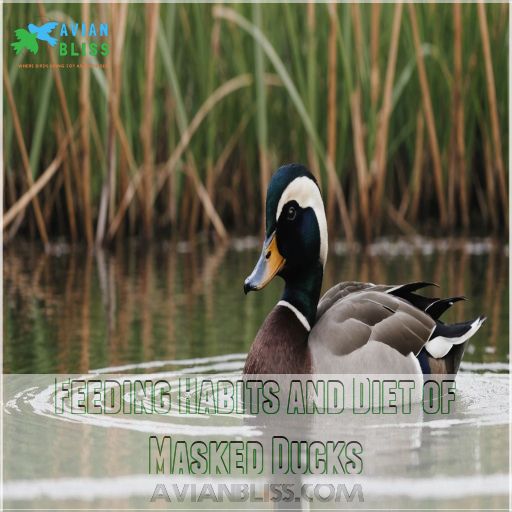This site is supported by our readers. We may earn a commission, at no cost to you, if you purchase through links.

They’re pros at playing hide-and-seek in dense vegetation, diving up to 22 feet deep for their next meal. Masked ducks are the ultimate underwater gourmets, feasting on plants, seeds, and tiny critters.
They’re not big on travel, preferring to chill in tropical haunts from Mexico to Argentina. But occasionally, they’ll surprise birdwatchers by popping up in unexpected places.
There’s more to these elusive ducks than meets the eye.
Table Of Contents
- Key Takeaways
- Masked Duck: a Unique Waterfowl Species
- Habitat Preferences of the Masked Duck
- Feeding Habits and Diet of Masked Ducks
- Breeding Behavior and Reproduction Strategies
- Conservation Status and Threats to Masked Ducks
- Masked Duck Distribution in Texas
- Comparison: Masked Duck Vs. Ruddy Duck
- Masked Duck Adaptations for Aquatic Life
- Challenges in Studying Masked Duck Populations
- Conservation Efforts for Masked Ducks
- Frequently Asked Questions (FAQs)
- How many masked ducks are in Texas?
- What is a masked duck?
- What does a Masked Duck look like?
- Is a Masked Duck tame?
- What is the difference between a Masked Duck and a Ruddy Duck?
- Where does the Masked Duck live?
- Who was Duck on Masked Singer?
- What is the diet of a Masked Duck?
- What does a masked ducks call sound like?
- How long can masked ducks stay underwater?
- Do masked ducks migrate seasonally?
- What predators pose threats to masked ducks?
- Can masked ducks be kept as pets?
- Conclusion
Key Takeaways
- You’ll be hard-pressed to find a more elusive waterfowl than the masked duck. These secretive swimmers are the ninjas of the wetlands, blending in with their surroundings like feathered chameleons. Their black face mask and bright blue bill make them look as if they’re ready for an underwater masquerade ball!
- Don’t expect these quirky ducks to follow the crowd when it comes to migration. Unlike their more predictable cousins, masked ducks are the free spirits of the bird world, wandering unpredictably and often under the cover of darkness. It’s as if they’ve torn up the rulebook on typical duck behavior!
- You might think counting ducks is a walk in the park, but tracking masked duck populations is more like finding a needle in a haystack – if the needle could swim and hide in dense vegetation. Their sneaky nature and preference for marshy hideouts make studying these birds a real challenge for researchers.
- If you’re hoping to spot a masked duck, you’d better brush up on your detective skills. These pint-sized paddlers prefer freshwater wetlands with plenty of plant cover, from Mexico to Argentina. However, don’t be surprised if they appear in unexpected places – they’ve been known to crash the party in Texas and Florida, keeping birdwatchers on their toes!
Masked Duck: a Unique Waterfowl Species
You’re about to meet a real character in the waterfowl world: the Masked Duck.
This small, secretive bird sports a distinctive black mask and brown speckled body.
It makes the bird stand out among its feathered friends in the wetlands of Central and South America.
Distinctive Physical Features
You’ll do a double-take when you spot a Masked Duck.
These tropical charmers sport a distinctive black face mask that’ll make you wonder if they’re off to a masquerade ball.
Their bright blue bill with a black nail is a real showstopper, contrasting beautifully with their gray body and buff-colored feathers.
Their wing patterns catch your eye too, with a smaller white patch adding flair to their blackish wings.
Size and Weight Comparison
Now that we’ve painted a picture of the Masked Duck’s striking features, let’s size up this pint-sized paddler.
Tipping the scales at a mere 1-1.2 pounds, Nomonyx dominicus is a featherweight champ in the duck world (Source).
Their compact build, perfect for zipping through aquatic vegetation, makes them masters of hide-and-seek in southern Texas’s shallow waters.
Sexual Dimorphism in Plumage
Talk about a fashion-forward feathered friend! The Masked Duck’s plumage is a masterclass in sexual dimorphism.
Males sport a dapper black mask with a bright eye ring, while females rock a more subdued look.
During mating season, guys amp up their style with dark-colored stripes and distinctive black mohawks, giving them an evolutionary edge in the dating game
.
It’s like nature’s own avian runway show, complete with camouflage couture and avian runway show.
Habitat Preferences of the Masked Duck
You’ll find Masked Ducks tucked away in freshwater wetlands across Central and South America, from Mexico to Argentina.
These elusive waterfowl prefer still or slow-moving waters with plenty of dense vegetation.
Making spotting one feel like winning a feathered lottery.
Freshwater Wetland Ecosystems
Let’s take a closer look at the Masked Duck’s favorite hangouts. These secretive waterfowl are true homebodies, preferring freshwater wetlands that’d make any duck feel cozy.
Picture shallow, marshy ponds with dense vegetation – it’s like nature’s version of a gated community! These wetlands are buzzing with biodiversity, from aquatic insects to lush plants.
Creating a buffet for our feathered friends, it’s a watery wonderland where Masked Ducks can hide, dine, and thrive, in an environment rich in biodiversity.
Geographic Range in the Americas
The Masked Duck’s range is like a wild rollercoaster ride across the Americas.
They’re regulars in tropical haunts but can pop up unexpectedly in places like Wisconsin or Massachusetts.
Their unpredictable wanderings make them tricky to pin down, but that’s part of their charm, isn’t it? They can be found from southern Texas and Florida down to South America, making them adventurous ducks indeed.
Seasonal Migration Patterns
Unlike their feathered friends who follow strict flight plans, Masked Ducks are the free spirits of the waterfowl world.
You’ll find these elusive birds playing a game of hide-and-seek with birdwatchers, as they wander unpredictably rather than migrate traditionally.
Their seasonal shenanigans include:
- Moonlighting as night owls, traveling under cover of darkness
- Invading Texas after unusually wet years create prime real estate
- Surprising ornithologists with unexpected appearances in northern states
- Embracing a "staycation" lifestyle in tropical habitats year-round
Feeding Habits and Diet of Masked Ducks
You’ll be surprised by the Masked Duck’s dining preferences, which go beyond your typical pond fare.
These elusive waterfowl have a knack for adapting their diet to what’s on nature’s menu, from aquatic plants to the occasional insect buffet.
Primary Food Sources
Ever wondered what’s on the menu for a masked duck? You’re in for a treat! These elusive waterfowl have quite the appetite, diving up to 22 feet deep for their favorite snacks.
They’re not picky eaters, but they do have some preferred dishes:
| Food Type | Examples | Foraging Method |
|---|---|---|
| Plants | Smartweed, millet | Diving |
| Seeds | Sedge, waterlily | Swimming |
| Insects | Aquatic bugs | Underwater propulsion |
| Crustaceans | Small crustaceans | Webbed feet power |
Talk about a buffet beneath the surface!
Dietary Variations by Season
You’ll be amazed how masked ducks shake up their menu as seasons change.
These clever birds adapt their diet to what’s available, like nature’s own foodies.
In winter, they’ll forage for hardy seeds and aquatic plants.
Come spring, they’re all about those juicy insects and small crustaceans.
Summer brings a smorgasbord of options, including fish and amphibians.
It’s like they’re playing culinary musical chairs with the changing seasons!
Adaptations for Aquatic Feeding
The Masked Duck’s bill is like a Swiss Army knife for aquatic dining.
Its broad, recurved shape is perfect for scooping up seeds and plant matter.
You’d be amazed at how these little guys can plunge up to 22 feet deep, foraging among emergent vegetation.
Their unique bill structure helps them outcompete other ducks for food, making them the ultimate underwater gourmets of the marsh, and they can be considered the ultimate aquatic dining experts.
Breeding Behavior and Reproduction Strategies
You’ll be amazed by the Masked Duck’s unique breeding habits, from elaborate courtship displays to ingenious nesting strategies.
These elusive waterfowl pull out all the stops during mating season, with males showing off their best moves.
Both parents team up to raise their ducklings in some of nature’s most challenging wetland environments.
Courtship Displays and Rituals
After filling their bellies, masked ducks turn their attention to love.
You’ll witness a flurry of activity as these feathered Casanovas strut their stuff. Head-bobbing and wing-flapping take center stage, with drakes performing short rushes and soft calls to woo the ladies.
It’s like a waterfowl dance-off, complete with circle-swimming and mate-guarding. Who knew ducks had such smooth moves?
Nesting Site Selection
Once the courtship dance ends, it’s time for these quirky ducks to find their dream home. Masked ducks are picky real estate agents, scouting for the perfect nesting spot. They’re all about location, location, location!
- Marshy neighborhoods with killer views
- Gated communities of dense vegetation
- Waterfront property with just the right depth
- Fixer-uppers ready for a down-feather makeover
Talk about high standards! But hey, when you’re raising a family, you can’t be too careful.
Egg-laying and Incubation Period
You’ve picked the perfect spot, now it’s time for the Masked Duck’s baby-making magic!
These feathered friends lay 4-6 creamy white eggs, carefully tucked away in their cozy nests.
| Stage | Duration |
|---|---|
| Egg-laying | 1-2 days |
| Incubation | 28 days |
| Pip to hatch | Up to 48 hours |
| Resting period | 12-24 hours |
| First swim | 1-2 days post-hatch |
Talk about playing the long game! These patient parents-to-be spend nearly a month warming their precious cargo.
Parental Care of Ducklings
The eggs have hatched, and now it’s time for some serious duckling development!
Masked Duck parents are like the unsung heroes of the waterfowl world. They’ve got their webbed feet full with nest defense, food provisioning, and managing sibling rivalry.
- Playing lifeguard: Ducklings can’t thermoregulate at first, so parents act as living blankets
- Serving up duck-cuisine: Parents lead ducklings to prime feeding spots
- Teaching "Duck, duck, predator!": Vigilant parents keep a watchful eye for threats
Conservation Status and Threats to Masked Ducks
Ever wondered why you don’t see Masked Ducks as often as other waterfowl?
These elusive birds face a tough battle against habitat loss, pollution, and hunting pressure, landing them on the "Near Threatened" list.
With only about 3,800 Masked Ducks estimated in Texas, conservationists are working hard to protect their wetland homes and keep these unique ducks paddling along.
Current Population Estimates
Pinpointing the Masked Duck’s population is like trying to count fish in a murky pond.
Current estimates range from 16,000 to a whopping 200,000 mature individuals . Despite this wide range, experts classify these elusive waterfowl as "Least Concern" on the conservation status scale.
Their population trend appears stable, but don’t let that fool you – these sneaky ducks are masters of hide-and-seek in their vast 26-million-square-kilometer range.
Habitat Loss and Degradation
Shrinking wetlands spell trouble for our feathered friends.
Masked ducks face a triple threat: wetland pollution, invasive species, and climate change. It’s like their woven bowl habitat is unraveling.
Agricultural runoff and urban development are turning their homes into toxic soup. These elusive waterfowl, once cataloged in Systema Naturae, now struggle to find clean waters.
We’re rewriting their ancient Greek tragedy, but there’s still time to flip the script and change the course of their fate, their triple threat still looming.
Hunting Pressure and Regulations
Ever wondered about the hunting pressure on masked ducks?
You’d be surprised to learn that they’re not specifically regulated in most waterfowl hunting guidelines. These elusive birds often fly under the radar of legal hunting regulations.
Conservation efforts focus on protecting their habitats rather than imposing strict bag limits. Ethical hunters play a key role in sustainable hunting practices by voluntarily limiting their take and supporting wetland preservation initiatives.
Climate Change Impacts
You might think hunting’s the biggest threat to masked ducks, but climate change is throwing them a curveball. Rising sea levels are swamping their coastal habitats, while extreme weather’s messing with their food supply (Source).
It’s like Mother Nature’s playing a game of "duck, duck, goose" with their homes.
Water quality’s taking a nosedive too, making it harder for these little guys to find a decent meal , highlighting the impact of extreme weather.
Masked Duck Distribution in Texas
You might be surprised to learn that the elusive Masked Duck makes rare appearances in Texas, with sightings scattered along the coastal plain from Hidalgo to Chambers County.
While breeding records are scarce, a handful of confirmed nesting attempts have been documented, including one at the Welder Wildlife Refuge, making Texas a unique outpost for this tropical waterfowl species, specifically the tropical waterfowl species.
Historical Sightings and Records
The Masked Duck‘s Texas tour has been quite the roller coaster ride. Since the 1960s, these elusive waterfowl have kept birdwatchers on their toes with sporadic sightings along the coast.
- Rare resident status established
- Population estimated at 3,800 birds in 1998
- Steady trickle of sightings over the years
- Occasional confirmed nestings
Despite their secretive nature, these ducks have managed to maintain a small but persistent presence in the Lone Star State.
Breeding Evidence in the State
In Texas, Masked Ducks are playing a game of hide-and-seek with ornithologists. These elusive waterfowl have been caught red-handed, breeding in the Lone Star State.
Let’s take a closer look at the evidence:
| Breeding Locations | Nesting Success |
|---|---|
| Freshwater swamps | Limited data |
| Canals | Threats present |
| Rice fields | Future research |
| Brackish ponds | Conservation key |
Despite their secretive nature, confirmed nesting has occurred in fall. Habitat conservation is important for these feathered Houdinis, as threats loom large. Future research might just unmask more of their breeding mysteries!
Seasonal Occurrence Patterns
Spotting a Masked Duck in Texas is like finding a needle in a haystack, but with a seasonal twist.
These elusive waterfowl pop up more frequently during wet years. They’re not big on long-distance travel, preferring to hunker down in their chosen habitats.
You’ll have better luck catching a glimpse during breeding season when they’re feeling a bit more sociable . Just don’t expect a grand migration spectacle!
Key Observation Locations
You’ve been tracking seasonal patterns, but now let’s zero in on where you can actually spot these elusive ducks in Texas.
The Texas Coastal Plain is your best bet, with several hotspots worth exploring:
- Welder Wildlife Refuge in San Patricio County
- Attwater Prairie Chicken NWR
- Hidalgo and Cameron Counties’ wetlands
- Coastal marshes and ponds
These areas are like hidden gems for birdwatchers – you might just stumble upon a Masked Duck when you least expect it!
Comparison: Masked Duck Vs. Ruddy Duck
You’ve probably seen a Ruddy Duck, but have you ever spotted its elusive cousin, the Masked Duck?
These two waterfowl species share some similarities, but they’ve got some key differences that’ll make you do a double-take next time you’re out birdwatching.
Physical Similarities and Differences
While exploring Texas wetlands, you might stumble upon two look-alike ducks: the masked and ruddy.
Let’s break down their differences like we’re comparing identical twins. You’ll need a keen eye to spot these distinctions!
| Feature | Masked Duck | Ruddy Duck |
|---|---|---|
| Bill shape | Swollen, blue | Broad, grey |
| Plumage | Cinnamon with face stripes | Chestnut with white cheeks |
| Tail length | Short, stiff | Longer, often raised |
| Body size | Smaller, compact | Larger, chunky |
| Wingspan | Narrower | Broader |
These feathered doppelgängers might fool you, but now you’re armed with duck detective skills!
Range Overlap in North America
The Masked Duck and Ruddy Duck often cross paths in North America, creating a duck-tastic spectacle for bird enthusiasts.
These feathered doppelgängers share more than just looks:
- Both species frequent freshwater marshes and ponds
- They’re expert divers, foraging underwater for tasty morsels
- Winter finds them mingling in coastal areas and southern states
Don’t be fooled by their similar swimming styles—competition and habitat sharing make for some interesting waterfowl drama!
Masked Duck Adaptations for Aquatic Life
You’ll be amazed by how well-equipped the Masked Duck is for life in the water.
From its specialized bill to its waterproof feathers, this little duck’s got some tricks up its sleeve that make it a true aquatic ace.
Bill Structure and Function
Let’s shift gears and take a gander at the masked duck’s bill – it’s a real Swiss Army knife of the waterfowl world!
This specialized beak is perfectly shaped for underwater foraging, allowing these clever ducks to snatch up aquatic plants and tiny critters with ease.
You’ll find their bill is slightly broader at the tip, giving them an edge in water manipulation and prey selection.
Talk about a handy tool for mealtime, a real handy tool!
Webbed Feet and Swimming Ability
You’d be amazed at how masked ducks glide through water like aquatic ballerinas.
Their webbed feet act as nature’s flippers, propelling them with surprising efficiency.
These adaptations aren’t just for show – they’re essential for underwater foraging and quick getaways from predators.
Picture a duck doing the backstroke, and you’re not far off!
Their unique webbing variations make them masters of aquatic acrobatics, leaving other waterfowl in their wake.
Diving and Underwater Behavior
Frequently, you’ll spot masked ducks diving like underwater ninjas. These aquatic acrobats have mastered the art of subaqueous living. They’re built for underwater foraging, with eyes adapted for crystal-clear vision beneath the surface. Ducks have almost 360-degree vision due to their eyes being positioned on the sides of their heads, aiding in predator spotting. aiding in predator spotting This helps them navigate underwater and spot prey, making them even more efficient hunters.
They can reach impressive depths, diving up to 10 feet.
- Impressive diving depth, reaching up to 10 feet
- Expert buoyancy control for effortless underwater maneuvering
- Lightning-fast prey capture skills, snagging fish and insects
Talk about a duck that’s made a splash in the evolution pool!
Waterproof Plumage Characteristics
The masked duck’s waterproof plumage is a marvel of nature.
Their feathers have an intricate structure with a waxy coating, created by oil from their preen gland . This clever arrangement keeps water at bay, even during long plunges.
You might say these ducks have their own built-in raincoats! Their downy underlayer stays dry, no matter how wet things get topside.
Talk about staying high and dry in style!
Challenges in Studying Masked Duck Populations
You’d think counting ducks would be easy, but masked ducks are the hide-and-seek champions of the wetlands.
Their secretive nature and preference for dense vegetation make tracking their populations a real head-scratcher for researchers.
They often feel like they’re trying to find feathered needles in a marshy haystack.
Elusive Nature and Secretive Habits
Because of their elusive nature, studying masked duck populations can be challenging. Think of it as trying to find a needle in a haystack, but with feathers instead of metal.
- Camouflage: Their plumage blends seamlessly with their surroundings, making them nearly invisible to the naked eye. This ability to blend in is similar to the wood duck’s preference for shallow serene waters, where their feathers can easily blend in with the surrounding vegetation and water. Additionally, the wood duck’s iridescent plumage may have inspired the masked duck’s own adaptations for camouflage.
- Nocturnal behavior: Masked ducks are often most active at night, making daytime observations difficult.
- Hidden nests: They build their nests in dense vegetation, far from prying eyes.
- Shy demeanor: Masked ducks are incredibly shy and easily spooked, making it difficult to approach them.
Difficulties in Population Surveys
Counting masked ducks is like trying to spot a ninja in a crowded mall. You’ll face a perfect storm of challenges:
| Challenge | Impact | Solution |
|---|---|---|
| Secretive behavior | Ducks hide from view | Use specialized survey techniques |
| Remote habitats | Limited access to sites | Employ remote sensing technology |
| Identification issues | Look-alike species confuse counts | Train observers in key field marks |
| Seasonal variation | Population fluctuates | Conduct surveys at consistent times |
| Limited data | Gaps in knowledge | Increase research efforts and funding |
Don’t let these elusive birds ruffle your feathers! With persistence and creativity, you’ll crack the masked duck mystery.
Limited Breeding Data Availability
Masked ducks’ breeding habits remain shrouded in mystery.
You’d have better luck finding a needle in a haystack than detailed breeding data on these elusive waterfowl. Research challenges abound, leaving ornithologists scratching their heads.
Citizen science efforts help fill data gaps, but it’s like piecing together a puzzle with half the pieces missing.
Future research calls for innovative monitoring methods to uncover the secrets of masked duck reproduction. Until then, we’re left with more questions than answers regarding these elusive waterfowl.
Identification Challenges in the Field
You’ve cracked the breeding data code, but hold onto your binoculars! Spotting Masked Ducks in the wild is like finding a needle in a haystack.
These waterfowl ninjas blend in with similar-looking ducks, using camouflage that’d make a birders jealous. Juvenile plumage adds another layer of mystery.
Even seasoned birders can mistake them for Rued Ducks. Your best bet? Grab a field guide, snap some photos, and prepare for a wild goose—er, duck—chase!
Conservation Efforts for Masked Ducks
You’re about to discover the impressive efforts underway to protect the elusive Masked Duck.
From wetland restoration to international teamwork, conservationists are pulling out all the stops to make sure these quirky waterfowl stick around for future generations to enjoy.
Conservationists are working hard to make sure these quirky waterfowl stick around for future generations to enjoy.
Wetland Restoration Projects
While studying these elusive ducks is tough, restoring their wetland homes is a feather in conservationists’ caps, where masked ducks can thrive in their natural habitats, much like their relatives who prefer more sheltered marshes, wooded swamps, and even coastal regions nearby marshes and swamps.
You can picture the transformation:
- Drained swamps refilled with life-giving water
- Native plants reclaiming their rightful place
It’s a process that helps masked ducks and other waterfowl species like geese that gravitate toward open areas like lakes, ponds, and streams. Masked ducks splashing happily in their renewed habitat
It’s not all smooth sailing, though. Funding challenges can ruffle some feathers, but with your support, we’re turning the tide on habitat loss. Every drop counts in improving water quality for these charming waterfowl!
Protected Area Designations
Beyond restoring wetlands, safeguarding the masked duck‘s future hinges on protected area designations. You’ll find these elusive waterfowl thriving in specially designated sanctuaries, where they’re free to splash and dive without a care in the world.
Let’s take a peek at how these protected areas are making waves for our feathered friends:
| Protected Area | Impact on Masked Ducks |
|---|---|
| Kulen Promtep Wildlife Sanctuary | Sole confirmed breeding site in Cambodia |
| Cuban Protected Areas | Extensive system supporting regional populations |
| Texas Wetlands | Periodic invasions during wet years |
These safe havens are the masked duck’s ticket to a much-needed respite from habitat loss and hunting pressures.
International Cooperation Initiatives
The Masked Duck’s elusive nature has sparked international cooperation efforts.
Countries across the Americas are joining forces to protect these nomadic waterfowl . You’ll find experts from Argentina to Texas collaborating on wetland conservation and habitat restoration projects.
They’re like detectives, piecing together the puzzle of the Masked Duck’s mysterious life.
Through species monitoring and research collaboration, they’re working to make sure these quirky ducks have a fighting chance in our ever-changing world.
Public Awareness and Education Programs
Spreading the word about masked ducks isn’t just for the birds! You can join the flock of conservationists by getting involved in public awareness programs.
- Participate in citizen science projects
- Support educational outreach initiatives
- Join habitat restoration efforts
By teaming up with conservation partnerships, you’ll become a duck detective, tracking these secretive swimmers. It’s like being a wildlife superhero – cape optional, but a good pair of binoculars is a must!
Frequently Asked Questions (FAQs)
How many masked ducks are in Texas?
Like counting needles in a haystack, estimating Texas’s elusive masked duck population is tricky.
In 1998, researchers put the number at about 3,800 birds.
Their secretive nature and marshy habitats make precise counts challenging, but they’re still rare residents.
What is a masked duck?
Imagine a duck playing hide-and-seek in tropical wetlands.
That’s your masked duck! This small, stealthy bird sports a black face mask (males) or striped cheeks (females).
They’re expert divers, feasting on aquatic plants and insects.
What does a Masked Duck look like?
You’ll spot a Masked Duck by its striking contrasts and clever camouflage.
Males sport a black face mask and chestnut body, while females rock a striped face and mottled plumage.
Their light-blue bills and dark eyes complete this avian masterpiece.
Is a Masked Duck tame?
Tame isn’t the word for these secretive birds.
Masked Ducks are naturally wary and elusive, preferring to skulk in dense vegetation.
They’re the stealth ninjas of the duck world, masters of the disappearing act when humans approach.
What is the difference between a Masked Duck and a Ruddy Duck?
Like two peas in a waterfowl pod, these ducks have distinct features.
Masked Ducks are smaller, with striking facial stripes and easier takeoffs. They are more elusive.
Ruddy Ducks are larger, with blue bills and stiffer tails. Both dive, but Masked Ducks are more elusive, in comparison to Ruddy Ducks.
Where does the Masked Duck live?
Picture tropical marshes and overgrown ponds – that’s where these elusive ducks thrive.
They’re homebodies in South America, but they’ll pop up in Texas and Florida for a surprise visit.
Talk about sneaky neighbors!
Who was Duck on Masked Singer?
Duck’s identity on The Masked Singer quacked everyone up.
It was Skin, the lead singer of Skunk Anansie.
She nearly let the cat out of the bag with her ear monitors but managed to keep her secret under wraps (Source).
What is the diet of a Masked Duck?
Masked Ducks aren’t picky eaters.
They’re found diving for aquatic plants, munching on seeds, roots, and leaves.
They’re not above snacking on insects and crustaceans either.
It’s like an underwater buffet for these secretive little swimmers!
What does a masked ducks call sound like?
Listen for low, laconic grunts and whistles.
You’ll hear soft ‘t r r r r r‘ sounds, typical of stifftail males.
These secretive swimmers aren’t chatterboxes, but their calls can be quite distinctive when you catch them.
How long can masked ducks stay underwater?
Ever wonder how long these aquatic ninjas can hold their breath?
While exact times aren’t well-documented, diving ducks typically stay submerged for 15-30 seconds.
They’re like underwater acrobats, efficiently hunting and evading predators in their watery playground.
Do masked ducks migrate seasonally?
Did you know only 4-10 eggs are laid by these elusive ducks?
Unlike typical migrants, masked ducks don’t follow seasonal patterns.
They’re nomads, wandering unpredictably, often at night.
You might spot them after unusually wet years in Texas.
What predators pose threats to masked ducks?
Predators lurk in the marshes, posing threats to these elusive ducks.
Larger birds, mammals, and reptiles might snatch them up.
You’d be surprised how many critters fancy a duck dinner!
Stay vigilant, little masked waddlers.
Can masked ducks be kept as pets?
Keeping exotic pets is like walking through a minefield – one wrong move can be disastrous.
In general, it’s not recommended to keep masked ducks as pets due to specific laws and regulations surrounding their ownership.
Conclusion
Dive deeper into masked ducks, and you’ll find they’re not just another pretty bill.
These secretive swimmers challenge our notions of what ducks can do, from their ninja-like diving skills to their tropical staycations.
As wetlands face threats, masked ducks remind us of nature’s hidden wonders.
So next time you’re near a marsh, keep your eyes peeled.
You might just spot one of these elusive waterfowl, sporting their trademark mask and blue bill, ready for their next underwater adventure.













